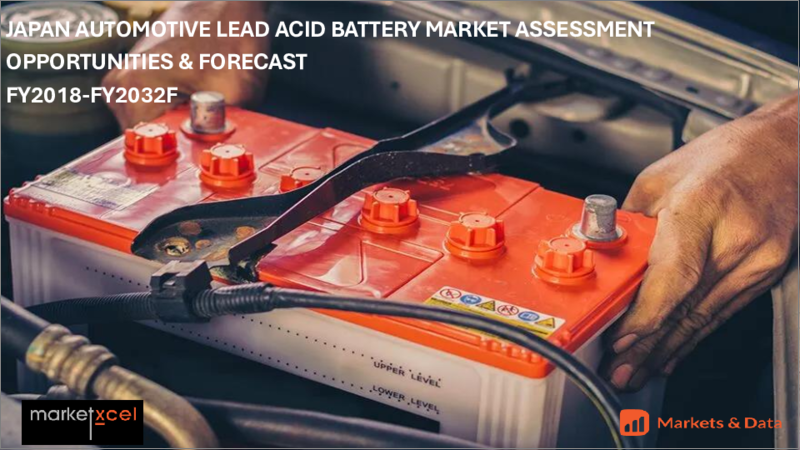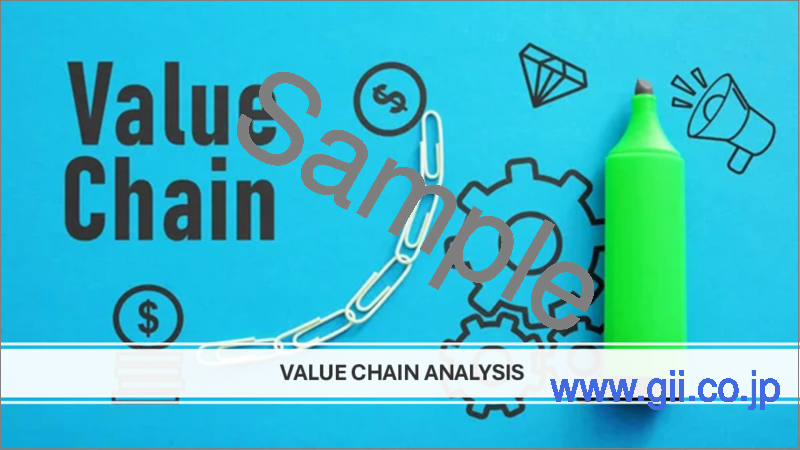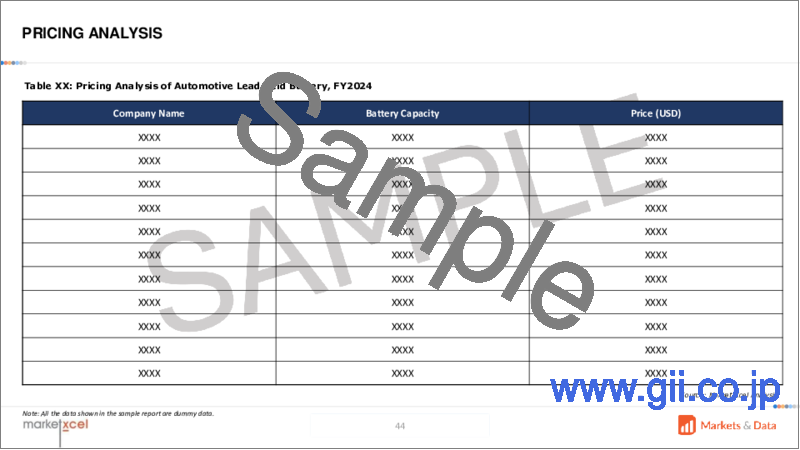|
|
市場調査レポート
商品コード
1597283
自動車用鉛蓄電池の日本市場の評価:車両タイプ別、電池容量別、販売チャネル別、地域別、機会、予測(2018年度~2032年度)Japan Automotive Lead Acid Battery Market Assessment, By Vehicle Type, By Battery Capacity, By Sales Channel, By Region, Opportunities and Forecast, FY2018-FY2032F |
||||||
カスタマイズ可能
|
|||||||
| 自動車用鉛蓄電池の日本市場の評価:車両タイプ別、電池容量別、販売チャネル別、地域別、機会、予測(2018年度~2032年度) |
|
出版日: 2024年11月26日
発行: Markets & Data
ページ情報: 英文 129 Pages
納期: 3~5営業日
|
全表示
- 概要
- 図表
- 目次
日本の自動車用鉛蓄電池の市場規模は、2024年度の19億6,000万米ドルから2032年度に22億1,000万米ドルに達すると予測され、2025年度~2032年度の予測期間にCAGRで1.51%の成長が見込まれます。市場は、電気自動車へのシフトの増加、自動車保有の飛躍的な増加、簡単に入手できる多様な鉛蓄電池、大幅な技術の進歩により、大きな成長を示しています。日本の自動車用鉛蓄電池市場の需要を促進しているその他の要因としては、エコ活動やエネルギー効率に対する政府のインセンティブ、革新的な鉛蓄電池技術の継続的開発、急速な都市化、持続可能な環境に関する意識の高まりなどがあります。加えて、日本の自動車用鉛蓄電池の需要が伸びているのは、鉛蓄電池がリチウムイオンを含む先進の電池技術よりも一般に安価であり、数十年にわたって自動車用途の標準となってきたためです。日本は電気自動車やハイブリッド車の主要製造国ですが、ほとんどの自動車は従来の内燃機関を使用しており、その点火は鉛蓄電池に依存しています。ハイブリッド車の増加に伴い、自動車用鉛蓄電池の需要は、よりよい運転体験を提供する補助機能により高まっています。さらに、日本政府は電池のリサイクルに関して厳しい規則と規制を設けており、鉛蓄電池が適切に廃棄およびリサイクルされることを確認しています。このような規制環境は、鉛蓄電池が適切に管理されれば環境への負荷が少ないことから、さまざまな自動車での鉛蓄電池の継続的な使用を支えています。
さらに、日本の自動車用鉛蓄電池市場の主要企業は、自動車の機能を進歩および向上させるため、さまざまな研究開発活動に投資しています。また、持続可能な輸送に対する需要の高まりに対応し、ネットゼロ二酸化炭素排出に寄与するため、企業は自動車用鉛蓄電池を組み込んだ自動車を日本で発売することを計画しています。
例えば、日本の主要企業であるGS Yuasa Corporationは2024年4月、Toyotaのハイブリッド車専用に設計されたECO.R HV補機VRLA電池シリーズのリニューアルを発表しました。
当レポートでは、日本の自動車用鉛蓄電池市場について調査分析し、市場規模と予測、市場力学、主要企業の情勢などを提供しています。
目次
第1章 プロジェクトの範囲と定義
第2章 調査手法
第3章 エグゼクティブサマリー
第4章 顧客の声
- 製品と市場情報
- ブランド認知度
- 購入決定において考慮される要素
- 機能とその他の付加価値サービス
- 電池の互換性
- ソリューションの効率
- アフターサポート
第5章 日本の自動車用鉛蓄電池市場の見通し(2018年度~2032年度)
- 市場規模の分析と予測
- 金額
- 数量
- 市場シェアの分析と予測
- 車両タイプ別
- 電池容量別
- 販売チャネル別
- 地域別
- 市場シェア分析:企業別(金額)(上位5社とその他 - 2024年度)
- 市場マップ分析(2024年度)
- 車両タイプ別
- 電池容量別
- 販売チャネル別
- 地域別
第6章 需給分析
第7章 輸入と輸出の分析
第8章 バリューチェーン分析
第9章 ポーターのファイブフォース分析
第10章 PESTLE分析
第11章 価格分析
第12章 市場力学
- 市場促進要因
- 市場の課題
第13章 市場の動向と発展
第14章 ケーススタディ
第15章 競合情勢
- マーケットリーダー上位5社の競合マトリクス
- 上位5社のSWOT分析
- 主要企業上位10社の情勢
- GS Yuasa Corporation
- Exide Technologies S.A.S.
- Panasonic Corporation
- The Furukawa Battery Co., Ltd.
- Mitsubishi Electric Corporation
- Hitachi, Ltd.
- KYOCERA Corporation
- Nippon Chemi-Con Corporation
- Energywith Co., Ltd.
第16章 戦略的推奨
第17章 当社について、免責事項
List of Tables
- Table 1. Pricing Analysis of Products from Key Players
- Table 2. Competition Matrix of Top 5 Market Leaders
- Table 3. Mergers & Acquisitions/ Joint Ventures (If Applicable)
- Table 4. About Us - Regions and Countries Where We Have Executed Client Projects
List of Figures
- Figure 1. Japan Automotive Lead Acid Battery Market, By Value, In USD Billion, FY2018-FY2032F
- Figure 2. Japan Automotive Lead Acid Battery Market, By Volume, In Units, FY2018-FY2032F
- Figure 3. Japan Automotive Lead Acid Battery Market Share (%), By Vehicle Type, FY2018-FY2032F
- Figure 4. Japan Automotive Lead Acid Battery Market Share (%), By Battery Capacity, FY2018-FY2032F
- Figure 5. Japan Automotive Lead Acid Battery Market Share (%), By Sales Channel, FY2018-FY2032F
- Figure 6. Japan Automotive Lead Acid Battery Market Share (%), By Region, FY2018-FY2032F
- Figure 7. By Vehicle Type Map-Market Size (USD Billion) & Growth Rate (%), FY2024
- Figure 8. By Battery Capacity Map-Market Size (USD Billion) & Growth Rate (%), FY2024
- Figure 9. By Sales Channel Map-Market Size (USD Billion) & Growth Rate (%), FY2024
- Figure 10. By Region Map-Market Size (USD Billion) & Growth Rate (%), FY2024
Japan automotive lead acid battery market is projected to witness a CAGR of 1.51% during the forecast period FY2025-FY2032, growing from USD 1.96 billion in FY2024 to USD 2.21 billion in FY2032. The market is witnessing significant growth owing to the increasing shift toward electric vehicles, increased vehicle ownership exponentially, the easily accessible variety of lead acid batteries, and significant technological advancements. Other factors driving the demand for Japan automotive lead acid battery market are government incentives for green practices and energy efficiency, continuous development of innovative lead acid battery technologies, rapid urbanization, and rising awareness concerning the sustainable environment. In addition, the demand for automotive lead acid batteries in Japan is growing because these are generally less expensive than advanced battery technologies, including lithium-ion, and have been a standard in automotive applications for decades. Although Japan is a key manufacturer of electric and hybrid vehicles, most automobiles use traditional internal combustion engines, whose ignition depends on lead acid batteries. With the increase of hybrid vehicles, the demand for automotive lead acid batteries is rising due to their auxiliary feature, which provides a better driving experience. Furthermore, the Japanese government has stringent rules and regulations for battery recycling, which confirms that lead acid batteries are properly disposed of and recycled. This regulatory environment supports the continued usage of lead acid batteries in various vehicles as they are less of an environmental burden when managed appropriately.
Additionally, the companies in Japan automotive lead acid battery market are investing in different research and development activities to advance and enhance vehicle features. Also, companies are planning to launch vehicles in Japan with the integration of automotive lead acid batteries to address the rising demand for sustainable transportation and contribute to net zero carbon emissions.
For instance, in April 2024, GS Yuasa Corporation, a leading Japanese company, announced the relaunch of its ECO.R HV auxiliary VRLA battery series, designed specifically for Toyota hybrid vehicles.
Vehicle Ownership and Fleet Expansion to Drive Market Growth
Japan automotive lead acid battery market is witnessing steady growth due to increased vehicle ownership and fleet expansion. Companies and businesses are expanding their vehicle fleets for delivery, logistics, and transportation services, further propelling the requirement for reliable and advanced automotive lead acid batteries. In addition, the dependency on personal vehicles is higher in rural and suburban locations, as transportation choices are restricted, leading to increased battery demand. Manufacturers of automotive lead acid batteries are introducing and offering advanced automotive lead acid batteries to offer an overall better driving experience.
Technological Advancements to Propel Japan Automotive Lead Acid Battery Market Demand
Companies in the market are advancing the automotive lead acid battery technology to enhance performance and longevity, making them more attractive to consumers and businesses, propelling the demand for Japan automotive lead acid battery market in the forecast period. Innovations in automotive lead acid battery design, including improved electrolyte formulations, result in batteries that offer better performance, increased reliability, and longer life. Also, advanced automotive lead acid batteries with maintenance-free features are obtaining popularity, decreasing the requirement for maintenance and making them more convenient for vehicle owners, fostering the growth of Japan automotive lead acid battery market growth in the forecast period. Companies in the Japanese market are offering advanced automotive lead acid batteries to address previous performance limitations and align with rising environmental and convenience considerations, propelling positive market growth in Japan for automotive lead acid batteries.
For instance, in October 2022, Japan's Toyota Motor Corporation and the domestic power utility giant JERA Group announced the commissioning of a second-life battery storage system that incorporates lithium-ion, nickel-metal-hydride, and lead acid chemistries.
Government Rules and Regulations to Drive Japan Automotives Lead Acid Battery Market Growth
The Japanese government forms stringent environmental regulations and robust recycling campaigns, propelling the growth of the market. The government introduced comprehensive recycling laws to ensure that automotive lead acid batteries are properly recycled, which reduces environmental impact and supports a sustainable market for these batteries. In addition, government initiatives often comprise logistic and financial incentives for the proper disposal and recycling of automotive lead acid batteries. This reduced the overall cost and encouraged more consumers and businesses to recycle and replace batteries responsibly. The supportive regulatory framework confirms environmental responsibility and strengthens consumer confidence in automotive lead acid batteries, supporting steady market growth in the forecast period.
For instance, in September 2024, the Japanese government announced subsidies of USD 2.4 billion to support electric vehicle battery projects of domestic manufacturers to ramp up the production of annual batteries and foster electrification efforts.
20-50Ah Batteries to Dominate Japan Automotive Lead Acid Battery Market Share
The 20-50Ah segment dominates the largest market share in Japan automotive lead acid battery market owing to the continuous prevalence of internal combustion engine vehicles and the rapid trend of personalization. 20-50Ah battery range is significant for ICE vehicles, ensuring reliable operation and powering the electrical systems. Although, the rising demand for electric and hybrid vehicles, along with the significant rise in the share of ICE vehicles in Japan, maintains a robust demand for a 20-50Ah battery range. In addition, companies are innovating battery design, including improved configurations, which have resulted in batteries that offer longer service life and better performance, fostering the growth of Japan 20-50Ah automotive lead acid battery market in the forecast period.
Passenger Cars to Hold the Significant Japan Automotive Lead Acid Battery Market Share
Passenger cars are projected to hold the dominating share of the Japanese market owing to the cost-effectiveness of automotive lead acid batteries and their effectiveness in powering the electrical systems of passenger cars. The easy affordability of automotive lead acid batteries for integration in passenger cars makes it a practical choice for many car owners, especially for replacement or budget-conscious applications. In addition, the demand for Japan passenger car market is rising owing to technological advancements and an increase in disposable income, which further drives the requirement for automotive lead acid batteries, offering sufficient power for the starting, lighting, and ignition functions in conventional passenger cars.
Future Market Scenario (FY2025 - FY2032F)
An increase in sales of electric vehicles and expansion in electronic applications within passenger vehicles are projected to propel the growth of Japan automotive lead acid battery market.
Easy accessibility of online purchasing for automotive products, including automotive lead acid batteries, supports market expansion in the forecast period.
Growing vehicle ownership and rapid urbanization, coupled with industrialization, are leading the market growth for automotive lead acid batteries.
Technological advancements to enhance durability and reduce maintenance demand are fostering the growth of the automotive lead acid battery market in Japan.
Key Players Landscape and Outlook
Companies in Japan automotive lead acid battery market are efficiently investing in different research and development activities to enhance the functioning of automotive lead acid batteries and strengthen their market position in the country and globally. Key participants in the Japanese market specialize in manufacturing plants for different types of automotive lead acid batteries and ensure that batteries meet the required specifications and standards. In addition, companies adjust their market growth strategies, including joint ventures, new product launches, amalgamation, partnerships, and others, to address the rising demand for automotive lead acid batteries and strengthen their market presence.
Table of Contents
1. Project Scope and Definitions
2. Research Methodology
3. Executive Summary
4. Voice of Customer
- 4.1. Product and Market Intelligence
- 4.2. Brand Awareness
- 4.3. Factors Considered in Purchase Decisions
- 4.3.1. Features and Other Value-Added Service
- 4.3.2. Battery Compatibility
- 4.3.3. Efficiency of Solutions
- 4.3.4. After-Sales Support
5. Japan Automotive Lead Acid Battery Market Outlook, FY2018-FY2032F
- 5.1. Market Size Analysis & Forecast
- 5.1.1. By Value
- 5.1.2. By Volume
- 5.2. Market Share Analysis & Forecast
- 5.2.1. By Vehicle Type
- 5.2.1.1. Passenger Car
- 5.2.1.2. Three-Wheeler
- 5.2.1.3. Two-Wheeler
- 5.2.1.4. Light Commercial Vehicle
- 5.2.1.5. Medium and Heavy Commercial Vehicle
- 5.2.2. By Battery Capacity
- 5.2.2.1. Up to 20Ah
- 5.2.2.2. 20-50Ah
- 5.2.2.3. Above 50Ah
- 5.2.3. By Sales Channel
- 5.2.3.1. Original Equipment Manufacturer
- 5.2.3.2. Aftermarket
- 5.2.4. By Region
- 5.2.4.1. North [Hokkaido and Tohoku]
- 5.2.4.2. Central [Kanto and Chubu]
- 5.2.4.3. South [Kansai, Chugoku, Shikoku, Kyushu, and Okinawa]
- 5.2.5. By Company Market Share Analysis (Top 5 Companies and Others - By Value, FY2024)
- 5.2.1. By Vehicle Type
- 5.3. Market Map Analysis, FY2024
- 5.3.1. By Vehicle Type
- 5.3.2. By Battery Capacity
- 5.3.3. By Sales Channel
- 5.3.4. By Region
6. Demand Supply Analysis
7. Import and Export Analysis
8. Value Chain Analysis
9. Porter's Five Forces Analysis
10. PESTLE Analysis
11. Pricing Analysis
12. Market Dynamics
- 12.1. Market Drivers
- 12.2. Market Challenges
13. Market Trends and Developments
14. Case Studies
15. Competitive Landscape
- 15.1. Competition Matrix of Top 5 Market Leaders
- 15.2. SWOT Analysis for Top 5 Players
- 15.3. Key Players Landscape for Top 10 Market Players
- 15.3.1. GS Yuasa Corporation
- 15.3.1.1. Company Details
- 15.3.1.2. Key Management Personnel
- 15.3.1.3. Products and Services
- 15.3.1.4. Financials (As Reported)
- 15.3.1.5. Key Market Focus and Geographical Presence
- 15.3.1.6. Recent Developments/Collaborations/Partnerships/Mergers and Acquisition
- 15.3.2. Exide Technologies S.A.S.
- 15.3.3. Panasonic Corporation
- 15.3.4. The Furukawa Battery Co., Ltd.
- 15.3.5. Mitsubishi Electric Corporation
- 15.3.6. Hitachi, Ltd.
- 15.3.7. KYOCERA Corporation
- 15.3.8. Nippon Chemi-Con Corporation
- 15.3.9. Energywith Co., Ltd.
- 15.3.1. GS Yuasa Corporation
Companies mentioned above DO NOT hold any order as per market share and can be changed as per information available during research work.





